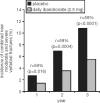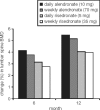Ibandronate: the first once-monthly oral bisphosphonate for treatment of postmenopausal osteoporosis
- PMID: 18360577
- PMCID: PMC1661644
Ibandronate: the first once-monthly oral bisphosphonate for treatment of postmenopausal osteoporosis
Abstract
Osteoporosis is a major healthcare problem that continues growing as the population ages. Sufferers become increasingly susceptible to fractures, which compromise physical and emotional health and increase healthcare costs. Bisphosphonates are the most widely used medicines for the treatment and prevention of postmenopausal osteoporosis. However, therapeutic adherence is suboptimal, meaning that outcomes demonstrated in clinical trials are not realized in the real world. It is anticipated that reducing dosing frequency may facilitate medication intake and thereby improve adherence. Ibandronate is a potent nitrogen-containing bisphosphonate specifically developed for administration with long dose-free intervals. The comprehensive ibandronate preclinical development program has demonstrated dose-dependent improvements or preservation of bone quality and strength. The feasibility of intermittent dosing using the same total dose level as continuous dosing was also confirmed. In postmenopausal osteoporosis, once-monthly oral ibandronate has been shown to be therapeutically equivalent and even superior to daily oral ibandronate, which has demonstrated antifracture efficacy for vertebral and nonvertebral fractures, bone mineral density gains at the spine and hip, and reduction in bone resorption to premenopausal levels. Once-monthly oral ibandronate is also associated with excellent safety and tolerability, and promises to further improve therapeutic adherence to bisphosphonate treatment, thereby enhancing therapeutic outcomes.
Figures







Similar articles
-
Beyond daily dosing: clinical experience.Bone. 2006 Apr;38(4 Suppl 1):S13-7. doi: 10.1016/j.bone.2006.01.152. Epub 2006 Mar 7. Bone. 2006. PMID: 16520105 Review.
-
Monthly oral ibandronate therapy in postmenopausal osteoporosis: 1-year results from the MOBILE study.J Bone Miner Res. 2005 Aug;20(8):1315-22. doi: 10.1359/JBMR.050313. Epub 2005 Mar 14. J Bone Miner Res. 2005. PMID: 16007327 Clinical Trial.
-
Update on monthly oral bisphosphonate therapy for the treatment of osteoporosis: focus on ibandronate 150 mg and risedronate 150 mg.Curr Med Res Opin. 2009 Dec;25(12):2951-60. doi: 10.1185/03007990903361307. Curr Med Res Opin. 2009. PMID: 19835464 Review.
-
Once-monthly dosing: an effective step forward.Bone. 2006 Apr;38(4 Suppl 1):S18-22. doi: 10.1016/j.bone.2006.01.153. Epub 2006 Mar 13. Bone. 2006. PMID: 16533625 Review.
-
Oral and intravenous ibandronate in the management of postmenopausal osteoporosis: a comprehensive review.Curr Pharm Des. 2005;11(28):3711-28. doi: 10.2174/138161205774580750. Curr Pharm Des. 2005. PMID: 16305506 Review.
Cited by
-
Impact of N-Acetyl Cysteine (NAC) on Tuberculosis (TB) Patients-A Systematic Review.Antioxidants (Basel). 2022 Nov 21;11(11):2298. doi: 10.3390/antiox11112298. Antioxidants (Basel). 2022. PMID: 36421484 Free PMC article. Review.
-
Bone physiology, disease and treatment: towards disease system analysis in osteoporosis.Clin Pharmacokinet. 2010;49(2):89-118. doi: 10.2165/11318150-000000000-00000. Clin Pharmacokinet. 2010. PMID: 20067335 Review.
-
Novel Approaches to Monitor Pharmacokinetics and Metabolism of Gemcitabine-Ibandronate Conjugate in Mice and Dogs.Molecules. 2025 Jan 16;30(2):354. doi: 10.3390/molecules30020354. Molecules. 2025. PMID: 39860223 Free PMC article.
-
Adherence to monthly and weekly oral bisphosphonates in women with osteoporosis.Osteoporos Int. 2010 Jan;21(1):145-55. doi: 10.1007/s00198-009-0930-1. Epub 2009 May 21. Osteoporos Int. 2010. PMID: 19459025 Free PMC article.
-
Radiolabeling, Quality Control, and Cell Binding Studies of New 99mTc-Labeled Bisphosphonates: 99mTc-Ibandronate Sodium.Turk J Pharm Sci. 2023 May 9;20(2):91-99. doi: 10.4274/tjps.galenos.2022.01346. Turk J Pharm Sci. 2023. PMID: 37161446 Free PMC article.
References
-
- Barrett J, Worth E, Bauss F, et al. Ibandronate: A clinical pharmacological and pharmacokinetic update. J Clin Pharmacol. 2004;44:951–65. - PubMed
-
- Bartl R, Goette S, Hadji P, et al. Persistence and compliance with daily- and weekly-administered bisphosphonates for osteoporosis in Germany [abstract p195] Osteoporos Int. 2005;16(Suppl 3):S45.
-
- Bauss F, Lalla S, Endele R, et al. The effects of treatment with ibandronate on bone mass, architecture, biomechanical properties and bone concentration of ibandronate in ovariectomized aged rats. J Rheumatol. 2002;29:2200–8. - PubMed
-
- Bauss F, Russell RGG. Ibandronate in osteoporosis: preclinical data and rationale for intermittent dosing. Osteoporos Int. 2004;15:423–33. - PubMed
LinkOut - more resources
Full Text Sources
